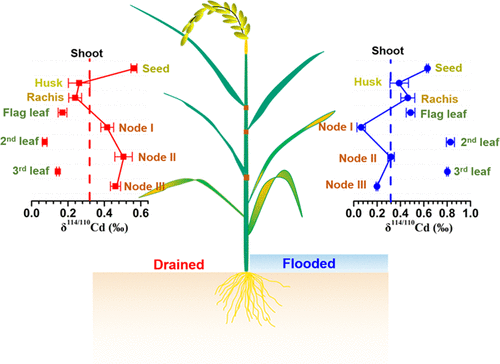当前位置:
X-MOL 学术
›
Environ. Sci. Technol.
›
论文详情
Our official English website, www.x-mol.net, welcomes your
feedback! (Note: you will need to create a separate account there.)
Water Management Alters Cadmium Isotope Fractionation between Shoots and Nodes/Leaves in a Soil-Rice System
Environmental Science & Technology ( IF 10.8 ) Pub Date : 2021-09-14 , DOI: 10.1021/acs.est.0c04713 Songxiong Zhong 1, 2, 3 , Xiaomin Li 4 , Fangbai Li 1 , Tongxu Liu 1 , Fang Huang 5 , Haoming Yin 5 , Guojun Chen 1 , Jianghu Cui 1
Environmental Science & Technology ( IF 10.8 ) Pub Date : 2021-09-14 , DOI: 10.1021/acs.est.0c04713 Songxiong Zhong 1, 2, 3 , Xiaomin Li 4 , Fangbai Li 1 , Tongxu Liu 1 , Fang Huang 5 , Haoming Yin 5 , Guojun Chen 1 , Jianghu Cui 1
Affiliation

|
The drainage of rice soils increases Cd solubility and results in high Cd concentrations in rice grains. However, plant Cd uptake is limited by sorption to iron plaques, and Cd redistribution in the plant is regulated by the nodes. To better understand the interplay of Cd uptake and redistribution in rice under drained and flooded conditions, we determined stable Cd isotope ratios and the expression of genes coding transporters that can transport Cd into the plant cells in a pot experiment. In soil, both water management practices showed similar patterns of isotope variation: the soil solution was enriched in heavy isotopes, and the root Fe plaque was enriched in light isotopes. In rice, the leaves were heavier (Δ114/110Cdleaf-shoot = 0.17 to 0.96‰) and the nodes were moderately lighter (Δ114/110Cdnode-shoot = −0.26 to 0.00‰) relative to the shoots under flooded conditions, indicating preferential retention of light isotopes in nodes and export of heavy isotopes toward leaves. This is generally reversed under drained conditions (Δ114/110Cdleaf-shoot = −0.25 to −0.04‰, Δ114/110Cdnode-shoot = 0.10 to 0.19‰). The drained treatment resulted in significantly higher expression of OsHMA2 and OsLCT1 (phloem loading) but lower expression of OsHMA3 (vacuolar sequestration) in nodes and flag leaves relative to the flooded treatment. It appeared that OsHMA2 and OsLCT1 might preferentially transport isotopically heavier Cd, and the excess Cd was purposefully retranslocated via the phloem under drained conditions when the vacuoles could not retain more Cd. Cd in seeds was isotopically heavier than that in stems under both water management practices, indicating that heavy isotopes were preferentially transferred toward seeds via the phloem, leaving light isotopes retained in stems. These findings demonstrate that the Fe plaque preferentially adsorbs and occludes light Cd isotopes on the root surface, and distinct water management practices alter the gene expression of key transporters in the nodes, which corresponds to a change in isotope fractionation between shoots and nodes/leaves.
中文翻译:

水分管理改变土壤-水稻系统中芽和节/叶之间的镉同位素分馏
水稻土壤的排水增加了 Cd 的溶解度,导致水稻籽粒中的 Cd 浓度升高。然而,植物对 Cd 的吸收受到铁斑吸附的限制,并且植物中 Cd 的重新分布受节点调节。为了更好地了解在排水和淹水条件下水稻中 Cd 吸收和再分布的相互作用,我们确定了稳定的 Cd 同位素比率和编码转运蛋白的基因的表达,这些转运蛋白可以在盆栽实验中将 Cd 转运到植物细胞中。在土壤中,两种水分管理实践都显示出相似的同位素变化模式:土壤溶液富含重同位素,根部 Fe 斑块富含轻同位素。在水稻中,叶子较重(Δ 114/110 Cd叶梢= 0.17 至 0.96‰) 并且节点相对于水淹条件下的枝条较轻 (Δ 114/110 Cd节点枝条= -0.26 至 0.00‰),表明节点中的轻同位素优先保留,重同位素向树叶。这通常在排水条件下逆转(Δ 114/110 Cd叶梢= -0.25 至 -0.04‰,Δ 114/110 Cd节点枝= 0.10 至 0.19‰)。排水处理导致OsHMA2和OsLCT1(韧皮部负载)的表达显着升高,但OsHMA3 的表达较低(液泡隔离)在节点和旗叶相对于淹没处理。似乎 OsHMA2 和 OsLCT1 可能优先运输同位素较重的 Cd,并且当液泡无法保留更多 Cd 时,多余的 Cd 在排水条件下通过韧皮部有目的地重新转移。在两种水分管理实践下,种子中的 Cd 同位素比茎中的要重,这表明重同位素优先通过韧皮部转移到种子中,而轻同位素保留在茎中。这些发现表明,Fe 斑块优先吸附和封闭根表面上的轻 Cd 同位素,不同的水分管理实践改变了节点中关键转运蛋白的基因表达,这对应于枝条和节点/叶之间同位素分馏的变化。
更新日期:2021-10-06
中文翻译:

水分管理改变土壤-水稻系统中芽和节/叶之间的镉同位素分馏
水稻土壤的排水增加了 Cd 的溶解度,导致水稻籽粒中的 Cd 浓度升高。然而,植物对 Cd 的吸收受到铁斑吸附的限制,并且植物中 Cd 的重新分布受节点调节。为了更好地了解在排水和淹水条件下水稻中 Cd 吸收和再分布的相互作用,我们确定了稳定的 Cd 同位素比率和编码转运蛋白的基因的表达,这些转运蛋白可以在盆栽实验中将 Cd 转运到植物细胞中。在土壤中,两种水分管理实践都显示出相似的同位素变化模式:土壤溶液富含重同位素,根部 Fe 斑块富含轻同位素。在水稻中,叶子较重(Δ 114/110 Cd叶梢= 0.17 至 0.96‰) 并且节点相对于水淹条件下的枝条较轻 (Δ 114/110 Cd节点枝条= -0.26 至 0.00‰),表明节点中的轻同位素优先保留,重同位素向树叶。这通常在排水条件下逆转(Δ 114/110 Cd叶梢= -0.25 至 -0.04‰,Δ 114/110 Cd节点枝= 0.10 至 0.19‰)。排水处理导致OsHMA2和OsLCT1(韧皮部负载)的表达显着升高,但OsHMA3 的表达较低(液泡隔离)在节点和旗叶相对于淹没处理。似乎 OsHMA2 和 OsLCT1 可能优先运输同位素较重的 Cd,并且当液泡无法保留更多 Cd 时,多余的 Cd 在排水条件下通过韧皮部有目的地重新转移。在两种水分管理实践下,种子中的 Cd 同位素比茎中的要重,这表明重同位素优先通过韧皮部转移到种子中,而轻同位素保留在茎中。这些发现表明,Fe 斑块优先吸附和封闭根表面上的轻 Cd 同位素,不同的水分管理实践改变了节点中关键转运蛋白的基因表达,这对应于枝条和节点/叶之间同位素分馏的变化。











































 京公网安备 11010802027423号
京公网安备 11010802027423号